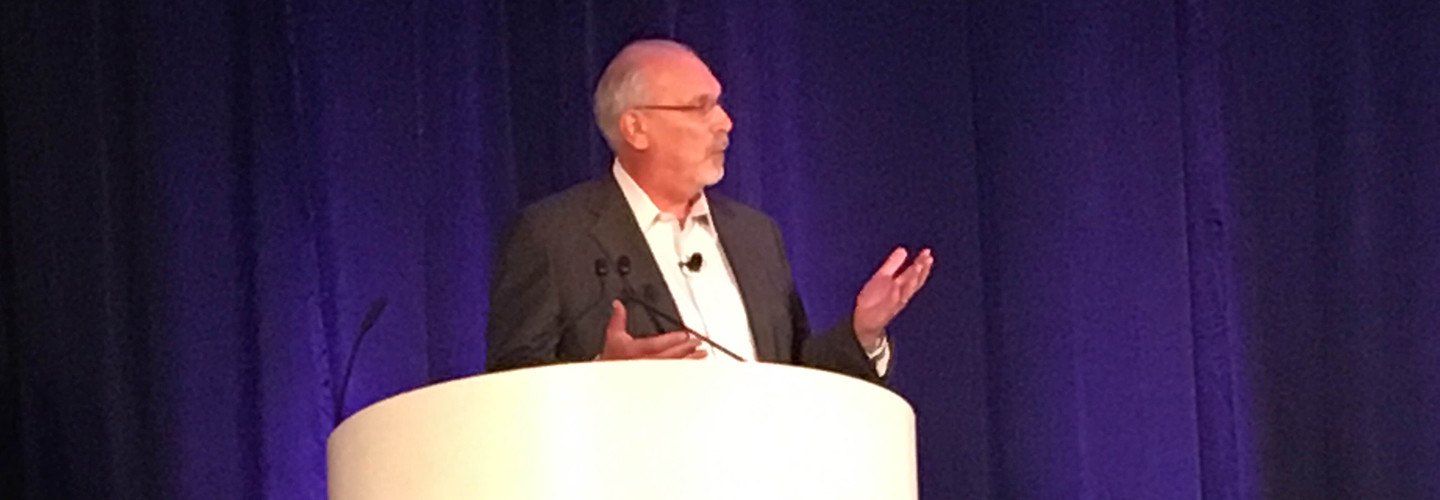Campus Technology 2016: Revolution Is in the Air
In his keynote address at Campus Technology 2016, educator and author Richard DeMillo predicted that technology will be the key to resolving the toughest challenges facing higher education. In his speech, “A Revolution in Higher Education: Tales from Unlikely Allies,” DeMillo said that this revolution may be quiet, but it is happening, as more educators and leaders embrace innovation.
DeMillo is executive director of the Center for 21st Century Universities at the Georgia Institute of Technology and the Charlotte B. and Roger C. Warren Professor of Computing. He is also the author of Abelard to Apple: The Fate of American Colleges and Universities and Revolution in Higher Education: How a Small Band of Innovators Will Make College Accessible and Affordable. His Aug. 2 speech kicked off the four-day conference in Boston.
“One way to think about revolution is people in the streets saying, ‘I want a revolution. I want to overthrow the old order.’ I don’t think that’s what’s going on here,” DeMillo said. “What I do see is a paradigm shift, a new way of thinking about what’s going on in our institutions.”
In this scenario, technology is an emerging solution that can boost access, affordability and achievement — challenges that DeMillo calls a “triple threat” for higher education. Paraphrasing 20th century inventor Buckminster Fuller, DeMillo said, “You don’t change the old order by fighting it. You change it by finding new inventions that make the old way obsolete.”
Old Rules No Longer Apply
DeMillo, whose experience spans academia, engineering, government and technology, noted that much has changed since he published his first book on education five years ago. What persists, he said, is his belief that higher education, for all its greatness, is not immune from the influence of politics, business, sociology and the economy.
In fact, he said, institutions’ track records suggests “there is nothing about our collective experience in running universities that would convince you that we are any wiser in choosing how we spend our money, any better in generating money and any more egalitarian in including those who may not be natural to include.”
One problem, he said, is that the model of education that has dominated until now — small classrooms built around lecture-based pedagogy — is too expensive to be sustainable. Technology, however, now makes it possible to deliver education that is equally effective, yet less costly and less exclusionary (think MOOCs, online learning and emerging capabilities such as artificial intelligence). All this prompts a revolutionary rethinking of time-tested assumptions, he said.
“When I talk about revolution, what I’m really talking about is a shift I’ve seen in the last five years toward serious institutions with serious leaders addressing these problems,” DeMillo said. “It should come as no surprise to you that technology is going to play a critical role in this story.”
At a Crossroads
DeMillo first noticed signs of a shift when MOOCs emerged and quickly spurred huge enrollments in online learning. At his own university, an online master’s program in computer science proved to be both intensely cost-effective and attractive to a broad group of students. Yet online classes run counter to the prevailing wisdom that small classes are the superior way to learn.
Small classes are indeed valuable, DeMillo agreed, but they are also “prohibitively expensive.” In reality, many college students now attend class in huge lecture halls, yet they are still subject to a teaching model built around small-class instruction, he said. Resolving that discrepancy is important for higher education: “The transition between looking at colleges and universities as factories, which they have to be to handle the numbers of students thrown at them, and the handcrafted, small-class experience is a gulf that is very difficult to cross.”
DeMillo frames this gulf as a crossroads between the past and the future. “This is a fight between methods of teaching that are thousands of years old and have come to us essentially unchanged, the long-form lecture … and something very different: education that’s informed by science, education that’s informed by research,” he said.
Customization for the Masses
One new model, mastery learning, calls for students to learn incrementally, test their progress along the way and get ample feedback. While such an approach might have been cost-prohibitive in the past, technology now makes it both attainable and, DeMillo argues, more effective.
“One of the things technology is extremely successful at is mass customization, mass personalization — giving people the idea that the education system is being responsive to their needs,” he said.
At many institutions, there are innovators — and revolutionaries — at work, even if that work occurs quietly and behind the scenes. Over time and in concert, these innovations will build up steam that ultimately will change the way higher education conducts business, DeMillo said. As that happens, he predicts that technology will be front and center: “A lot will depend on the nature and the kind of technology that we bring to bear.”
Catch more updates from Campus Technology 2016 on EdTech's official event page.








